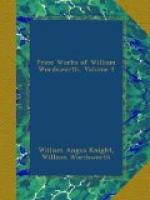When I sent you, a few weeks ago, ‘The Tale of Peter Bell,’ you asked ’why “The Waggoner” was not added?’—To say the truth,—from the higher tone of imagination, and the deeper touches of passion aimed at in the former, I apprehended, this little Piece could not accompany it without disadvantage. In the year 1806, if I am not mistaken, ‘The Waggoner’ was read to you in manuscript, and, as you have remembered it for so long a time, I am the more encouraged to hope that, since the localities on which the Poem partly depends did not prevent its being interesting to you, it may prove acceptable to others. Being therefore in some measure the cause of its present appearance, you must allow me the gratification of inscribing it to you; in acknowledgment of the pleasure I have derived from your Writings, and of the high esteem with which I am very truly yours,
WILLIAM WORDSWORTH.
Rydal Mount, May 20, 1819.
122. *_The Waggoner_.
Town-End, 1805. The character and story from fact.
123. Benjamin ’the Waggoner.’
Several years after the event that forms the subject of the Poem, in company with my friend, the late Mr. Coleridge, I happened to fall in with the person to whom the name of Benjamin is given. Upon our expressing regret that we had not, for a long time, seen upon the road either him or his waggon, he said:—’They could not do without me; and as to the man who was put in my place, no good could come out of him; he was a man of no ideas.’
The fact of my discarded hero’s getting the horses out of a difficulty with a word, as related in the poem, was told me by an eye-witness.
124. The Dor-Hawk.
‘The buzzing Dor-hawk round and round is wheeling’ (c. i. l. 3).
When the Poem was first written the note of the bird was thus described:—
’The Night-hawk is singing
his frog-like tune,
Twirling his watchman’s
rattle about’—
but from unwillingness to startle the reader at the outset by so bold a mode of expression, the passage was altered as it now stands.
125. Helmcrag (c. i. l. 168).
A mountain of Grasmere, the broken summit of which presents two figures, full as distinctly shaped as that of the famous Cobbler near Arroquhar in Scotland.
126. Merrynight (c. ii. l. 30).
A term well known in the North of England, and applied to rural festivals where young persons meet in the evening for the purpose of dancing.
‘The fiddles squeak—that call to bliss’ (c. ii. l. 97).
At the close of each strathspey, or jig, a particular note from the fiddle summons the Rustic to the agreeable duty of saluting his partner.
127. Ghimmer-Crag (c. iii. l. 21).
The crag of the ewe-lamb.
VI. POEMS OF THE IMAGINATION.
128. *_There was a Boy_. [I.]




